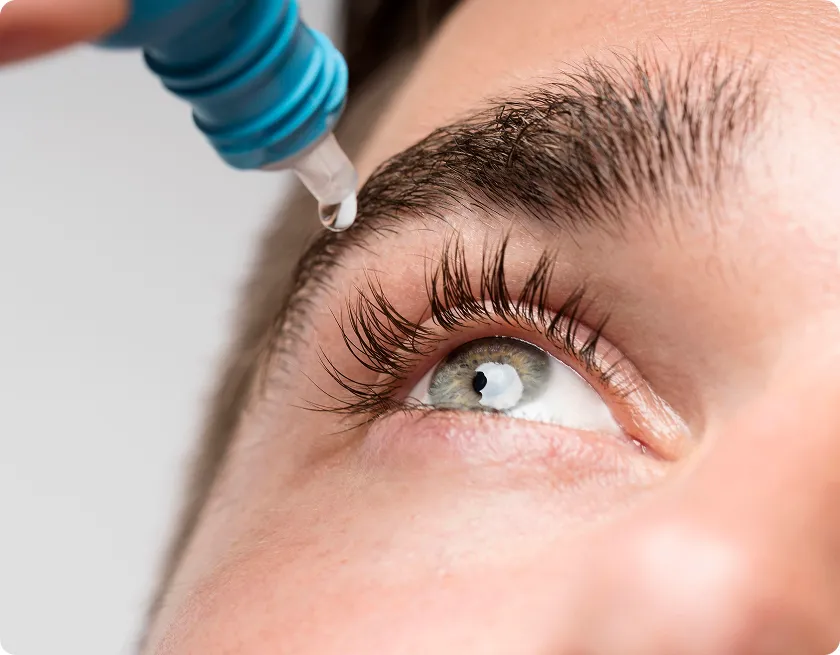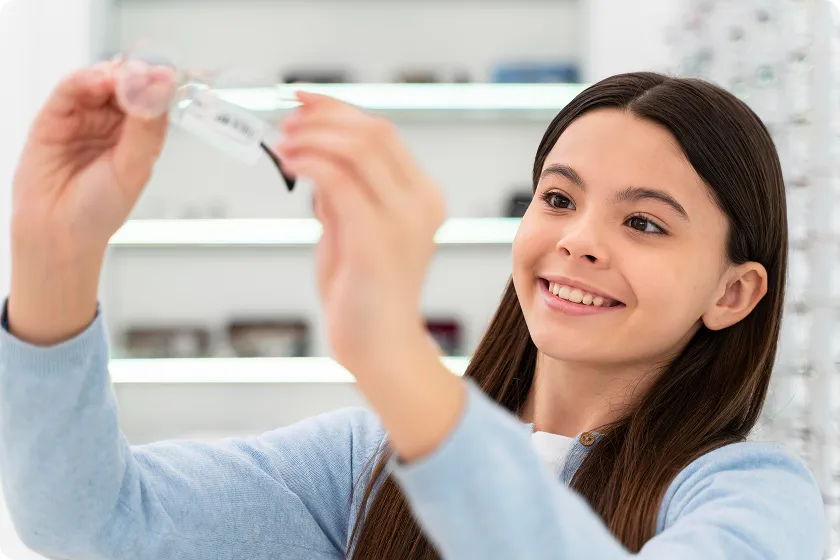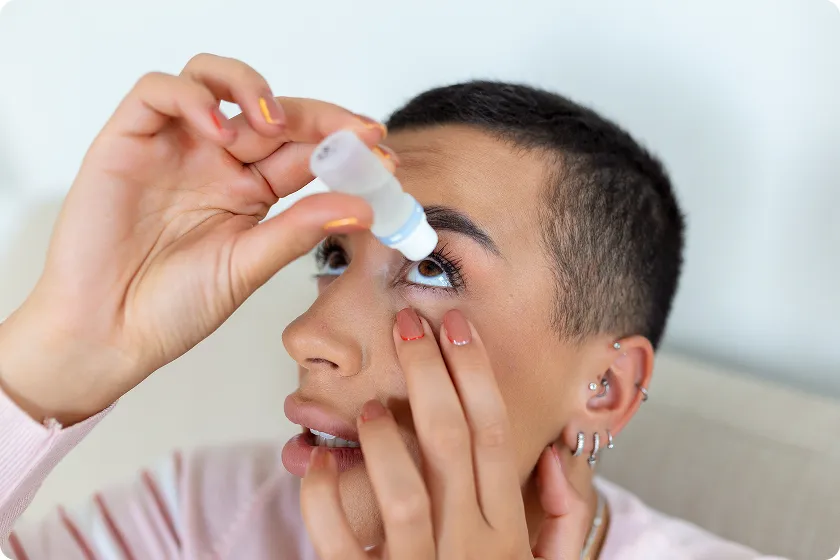Table of Contents
- Introduction
- Understanding Eye Drops for Contact Lenses
- Common Reasons for Dry Eyes and Contact Lenses
- Choosing the Right Eye Drops for Contact Lens Users
- Top 11 Eye Drops for Contact Lenses
- Eye Drop Safety and Best Application Practices
- Caring for Gas Permeable and Rigid Gas Permeable Contact Lenses
- When Contact Lens Issues Signal a Problem
- FAQs About Eye Drops and Contact Lenses
- Conclusion
Introduction
If you’ve ever worn contact lenses, you know how amazing it feels to see clearly without glasses—until your eyes start to feel dry, gritty, or irritated. Dry eyes and contact lenses don’t mix well. The discomfort can distract you from work, make it hard to focus, and sometimes even force you to remove your lenses earlier than planned.
Fortunately, the right eye drops for contact lenses can restore comfort, hydration, and clarity. Whether you wear soft lenses or gas permeable contact lenses, choosing the proper rewetting solution can make a world of difference.

This article explores the 11 ultimate types of eye drops suitable for contact lens users, how to pick the best one for your needs, and expert tips for safe use. You’ll also learn about managing dryness, cleaning lenses properly, and what to do if a contact lens gets stuck in your eye.
Let’s dive in and discover how you can keep your vision fresh, comfortable, and irritation-free every day.
Understanding Eye Drops for Contact Lenses
Contact lenses naturally reduce the amount of oxygen reaching the surface of your eyes. Combined with long hours of screen time or dry environments, this can lead to irritation or redness. Eye drops for contact lenses, often called lens rewetting drops, are specifically designed to keep your lenses moist and comfortable throughout the day.

Unlike ordinary lubricating eye drops, rewetting drops are formulated without preservatives or harsh chemicals that could damage the lens or irritate your eyes. Some are compatible with multipurpose contact lens solutions, while others are made purely for on-the-go relief. These drops not only soothe dryness but also improve lens performance—enhancing vision clarity, preventing protein buildup, and prolonging wear time safely.
Types of Eye Drops for Contact Lens Wearers
Different types of rewetting drops serve different purposes. Here’s a quick breakdown:
| Type | Best For | Features |
| Saline solution for contact lenses | Rinsing and temporary relief | Simple, preservative-free hydration |
| Rewetting drops | Daily comfort while wearing lenses | Safe for direct use with lenses on |
| Lubricating drops | Severe dryness (remove lenses first) | Long-lasting moisture |
| Multipurpose contact lens solution | Cleaning and disinfecting | Not for rewetting during wear |
Note: Always confirm whether a product is labeled “for use with contact lenses.” Regular lubricants may blur vision or cause lens buildup if used incorrectly.
Common Reasons for Dry Eyes and Contact Lenses
Even the best contact lenses can cause dryness over time. Factors like low humidity, extended wear, or improper cleaning routines can make your eyes feel tired or scratchy.

Eye dryness management involves understanding the root causes:
- Reduced tear production: Common in aging adults or due to certain medications.
- Environmental exposure: Air conditioning, wind, or screens that reduce blinking frequency.
- Poor lens hygiene: Using the wrong solution or not cleaning lenses properly.
- Lens age and fit: Wearing expired or ill-fitting lenses can block oxygen flow.
By addressing these triggers and maintaining a proper contact lens hygiene routine, you can prevent dryness before it starts.
Contact Lens Hygiene Tips for Healthier Eyes
A few simple habits can help keep your eyes comfortable:
- Wash and dry your hands before handling lenses.
- Replace lenses according to your lens replacement guidelines.
- Store lenses in fresh solution daily.
- Avoid sleeping in lenses unless prescribed.
- Use lens rewetting drops as needed during wear.
Small changes like these help maintain healthy tears, clear vision, and all-day comfort.
Choosing the Right Eye Drops for Contact Lens Users
Not all eye drops are created equal. Some lubricants are too thick, while others contain preservatives that can irritate. When choosing eye drops for contact lenses, always check for compatibility, ingredients, and intended use.

1. Look for Preservative-Free Formulas
Preservatives extend shelf life but may irritate sensitive eyes, especially with frequent use. Opt for single-use preservative-free vials if your eyes are prone to redness or stinging.
2. Check Osmolarity and pH Balance
Eye drops should closely match your natural tear composition. A balanced pH keeps the drops gentle and non-stinging, while proper osmolarity prevents over-dilution of your tear film.
3. Avoid Vasoconstrictors
“Redness-relief” drops often contain vasoconstrictors that temporarily shrink blood vessels. While effective short term, they can cause rebound redness. For contact lens users, stick with gentle rewetting solutions instead.
4. Comparing Common Eye Drop Types
| Type | Preservative-Free? | Safe for Lenses? | Best Use Case |
| Saline solution | Yes | Yes | Quick hydration or rinsing |
| Artificial tears | Some | No | After removing lenses |
| Rewetting drops | Yes | Yes | On-the-go moisture boost |
| Multipurpose solution | No | For cleaning only | Disinfection and storage |
Top 11 Eye Drops for Contact Lenses
While this guide stays brand-neutral, these 11 types of eye drops represent the main categories you’ll encounter, each tailored for specific needs.

1. Daily Comfort Rewetting Drops
These drops restore moisture instantly during wear. Ideal for mild dryness caused by long hours at work or study.
2. Preservative-Free Hydration Drops
Perfect for sensitive eyes or anyone with allergies. Each vial provides fresh, sterile hydration without chemicals.
3. Extended-Wear Moisturizing Drops
Specially designed for contact wearers who use extended-wear or overnight lenses. Keeps lenses hydrated longer.
4. Protein-Removal Compatible Drops
Help prevent lens fogging and buildup, improving clarity and comfort. Ideal for weekly or biweekly lens users.
5. Sensitive-Eye Rewetting Drops
Gentle and soothing, these drops mimic natural tears. Great for people who experience irritation after long screen time.
6. Lubricating Gel Drops (Remove Lenses First)
Offer thicker relief for severe dryness. Not for use while wearing lenses, but perfect for recovery after removal.
7. Saline-Based Drops
Simple and effective hydration. Great for rinsing rigid gas permeable contact lenses or flushing out debris safely.
8. Long-Lasting Moisture Drops
Formulated with hydrating polymers that bind water molecules, keeping eyes lubricated for hours.
9. Cooling Rewetting Drops
Provide a refreshing sensation, ideal for tired eyes after long computer sessions.
10. Allergy Relief Drops for Contact Lens Wearers
If you suffer from seasonal allergies, these antihistamine-compatible rewetting drops soothe itching and burning without damaging lenses.
11. Post-Lens Removal Recovery Drops
Perfect for soothing the eyes after long wear. Helps replenish tears and prevent corneal abrasion from contact lenses.
Eye Drop Safety and Best Application Practices
Even safe products can cause problems if used incorrectly. Proper application helps you avoid contamination and ensures maximum comfort.

How to Apply Eye Drops with Contact Lenses On
- Wash your hands thoroughly.
- Tilt your head back and look upward.
- Hold the bottle about an inch above your eye.
- Apply one drop, then blink gently to spread it evenly.
- Wait a few seconds before applying a second drop if needed.
Always discard single-use vials after opening to prevent bacterial buildup.
Adverse Effects of Wrong Lens Solution
Using incompatible drops or expired products can cause:
- Stinging or burning sensations
- Cloudy vision
- Redness or swelling
- Increased dryness
If these symptoms occur, stop using the product and consult your eye care professional.
Caring for Gas Permeable and Rigid Gas Permeable Contact Lenses
Gas permeable contact lenses (GP lenses) and rigid gas permeable contact lenses offer excellent vision correction with GP lenses due to their durability and oxygen permeability. However, they require more meticulous care.

Why Are Gas Permeable Contact Lenses Recommended?
Sharper vision and a lower chance of corneal distortion are two benefits of their superior shape retention over soft lenses. Additionally, they increase the amount of oxygen that reaches your eyes, which supports long-term eye health.
How Do I Clean Gas Permeable Contact Lenses Correctly?
- Place the lens on your palm.
- Apply a few drops of approved cleaning solution.
- Rub gently with your fingertip for 10–15 seconds.
- Rinse with saline solution for contact lenses before storing.
Never use tap water—it contains microorganisms that can cause infections.
What Are the Benefits of Rigid Gas Permeable Lenses?
- Exceptional visual clarity
- Long lifespan
- Better resistance to protein buildup
- Customizable fit for specific prescriptions
However, expect a brief lens adaptation period when switching from soft lenses.
When Contact Lens Issues Signal a Problem
Discomfort can sometimes refer to more than just dryness. Don’t ignore pain, redness, or blurred vision if your contact lens becomes lodged in your eye.

What Causes a Contact Lens to Stick in the Eye?
Usually, dryness or improper insertion is the culprit. Blinking or using rewetting drops often helps loosen it. Avoid rubbing your eye—this can cause a corneal abrasion from contact lenses.
What to Do If a Contact Lens Won’t Come Out
- Wash your hands.
- Apply a few saline drops or rewetting solution.
- Gently massage the eyelid.
- If it still won’t release, seek professional help immediately.
Persistent stuck lenses can cause irritation or even minor injury.
When Should I See a Doctor for Contact Lens Problems?
Visit an eye specialist if you notice:
- Sharp pain or severe redness
- Light sensitivity
- Discharge or blurred vision
- Persistent dryness despite using drops
Prompt treatment prevents long-term complications and protects your vision.
FAQs About Eye Drops and Contact Lenses
Curious about safe practices or wondering how to pick the right drops? Here are the most common questions contact lens wearers ask.
1. How Do I Choose Comfortable Contact Lenses?
Choose lenses based on your eye shape, lifestyle, and moisture needs. A professional fitting ensures optimal comfort and oxygen flow, reducing dryness and irritation.
2. Can Stuck Contact Lenses Damage My Eyes?
Yes. Prolonged friction can lead to corneal abrasion or infection. If your lens feels stuck, lubricate your eye immediately and seek professional care if it doesn’t release.
3. What Is the Difference Between Gas Permeable and Soft Lenses?
Gas permeable lenses are firm and provide sharper vision, while soft lenses are flexible and more comfortable initially. Each has distinct advantages depending on your prescription and lifestyle.
4. What Are Signs of Discomfort with Contact Lenses?
Common signs include dryness, redness, and blurred vision. Persistent discomfort may indicate poor lens hygiene or an incorrect fit—consult your optometrist promptly.
5. When Should I Replace My Eye Drops?
Check the expiration date. Once opened, single-use vials should be discarded immediately; multi-use bottles usually last 30–60 days depending on preservatives.
Conclusion
One of the easiest yet most efficient methods to enhance comfort and preserve good vision is to use the appropriate eye drops for contact lenses. Proper lubrication keeps your eyes hydrated, clear, and irritation-free, whether you wear rigid gas-permeable or soft contact lenses.

Remember: good contact lens hygiene, proper cleaning, and regular eye checkups are just as important as the drops you choose. If you experience persistent dryness, pain, or blurred vision, consult your eye doctor for personalized guidance.
Healthy eyes mean confident, comfortable vision—every day.
Internal Links
- Colon Cleanse Diet: 7 Proven Herbal Methods for Safe Use
- Skin Care Routine for Oily Skin: 9 Effective Tips
- Sleep Hygiene Checklist: 8 Complete Ways to Increase Rest




